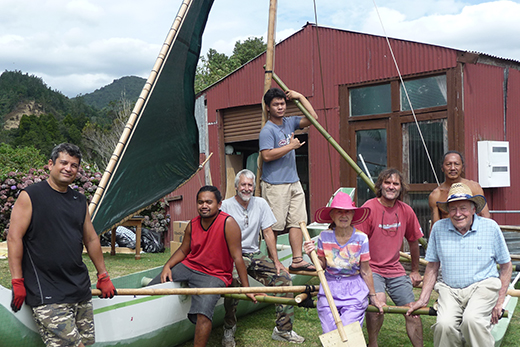Proa hold a unique place in the annals of sailing technology, being among the family of Pacific multi-hulls that introduced the idea of speed to European voyagers. When ships like the Endeavour had a cruising speed of about four knots, and a maximum of eight knots, the islander double-hulled canoes were astonishingly fast by comparison. A recorded speed of a Gilbertese flying proa touching 17 knots, and a Carolines outrigger boat averaging 12.5 knots during the 1200 nautical mile voyage from Guam to Manilla are still considered exceptional speeds. The proa used to be ubiquitous. Derek Kelsall, who hosted the recent build of a foam sandwich proa at his shed near Waihi, says there were hundreds of them around where the builders came from – Saipan in the Northern Marianas. “It’s certainly not the only foam sandwich proa, but it’s certainly the only kind to an ancient design,” says Derek. “There are modern proas. I did three or four 25 years ago. They were quite popular for a little while as a way of getting quite a long boat for the least amount of money. “To some extent that still applies, but this is still the only example of foam sandwich combined with the old traditional bamboo, and whatever cloth you have got around for the sails. “It was a very interesting project for me, combining the old and the new and getting the best out of both in many ways.” The project is being steered by Peter Perez in an effort to revive the sailing traditions of Saipan and Guam. The 500 Sails project is inspired by the record of the arrival of the sailing ship San Pedro in Guam in 1575, where it was greeted by 500 outrigger canoes. The project is to create a fleet of 500 canoes for the people of the Marianas. The Kelsall-built proa with Derek Kelsall (right)) with the team at Waihi. Using the original Sir George Anson expedition drawing from 1742 and new technology, the project will construct traditional Chamorro canoes of various sizes from fibreglass and put them in the hands of people who can learn how to build them and share in the knowledge of seafaring and navigation. The project will teach valuable skills and promote a viable boat-building industry. Ultimately, the 500 Sails project will help the children of the Marianas remember who they are as a people with a rich seafaring history. “There will probably be other models, the purpose at the moment is to try and get as many of the islanders sailing as possible,” says Derek. “It’s quite an ambitious project. He has a good US grant to get it off the ground.” Proa did a lot of open ocean sailing, says Derek. They had one big hull and one small hull and lots of speed. One hull is always kept to windward, so it needs to shunt to change tack. “This proa, the Chammoro proa, they swing the foot of the sail from one end of the boat to the other and they are using paddles to steer the boat. Keeps it fairly simple.” Derek didn’t have a chance to sail it. They ran out of time and it was packed into a container for the delivery voyage. “If we had had one or two more days we could have got it on the water,” says Derek.



0 Comments
Leave a Comment